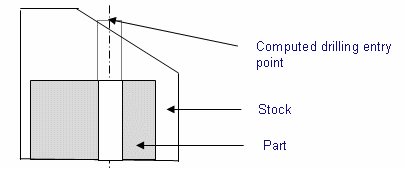
The information in this section will help you create and use intermediate stock in your program.
You can also refer to the user task Using Intermediate Stock which shows how to compute and visualize intermediate stock in a program.
This capability is enabled by selecting the Intermediate stock for milling and turning operations check box in the Option tab of the Part Operation editor.
Input and output intermediate stock can be created and visualized for all
types of machining operations. Different types of operation can be mixed in
your program. Also a milling operation is allowed after a turning operation
and, inversely, a turning operation is allowed after a milling operation.
The stock is taken into account to optimize and compute a collision free toolpath.
Input Intermediate Stock: solid corresponding to the machined part before the machining operation.
Output Intermediate Stock: solid corresponding to the machined part after the machining operation.
Input Stock contour: profile corresponding to the maximum turning envelope of the Input Intermediate Stock.
Output Stock contour: profile corresponding to the maximum turning envelope of the Output Intermediate Stock.
Stock synchronized with the operation: To manage the life cycle the stock is linked with a specific version of the tool path of the operation. If the toolpath is changed, the stock is no longer synchronized.
Note: The intermediate stock bodies and contours are not stored. They are available only during the session of the CATProcess. The process must be linked to a CATProduct.
A user task showing how to compute and visualize intermediate stock in a program is provided in Using Intermediate Stock.
Machining options to manage Intermediate Stock display color and transparency are available in Tool > Options > Machining > General.
In order to visualize transparency variations you have to set the transparency quality to High (Alpha Blending) in Tools > Options > Display > Performance.
In a Lathe context, while editing the operations, the Intermediate Stock contour is computed. In order to display this contour correctly, you have to set the pixel culling parameters to 0 in Tools > Options > Display >Performance.
Lathe operations can be mixed with milling operations.
Input and Output stock can be computed on any turning operation
Note: The activation of intermediate stock option the Part Operation editor means that the Automatic stock selection for turning operations capability is deactivated.
Drilling Point
Drilling entry point is computed on the stock.
If this computed point is above the selected one, it will replace the selected
one.
If a Top element is selected and the computed point is above the Top element,
then the Top element will not be taken into account.

All axial operations (Drilling, Spot Drilling, Circular Milling, and so on) support intermediate stock.
Linking motions
The linking motions between drilling points are computed according to intermediate
stock.
Linking macro motion is done up to the intermediate stock.
Collisions are checked with the tool along the linking motion.
The Stock Clearance defined on the Part operation is used to define motion without collision with the current stock.
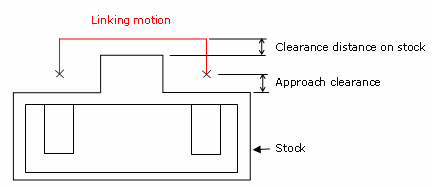
All axial operations (Drilling, Spot Drilling, Circular Milling, and so on) support intermediate stock.
Top Plane
The top plane of the intermediate stock is automatically computed in the machining
area by relimiting the input stock with the machining area:
All milling operations support intermediate stock. However, the following operations support intermediate stock and automatic top plane computation:
Pocketing
Facing
Profile contouring
Prismatic roughing
Roughing
Plunge milling
Cavities roughing.
The following operations support intermediate stock and tool path optimization:
Pocketing
Facing
Prismatic roughing
Roughing
Plunge milling
Cavities roughing.
Tool path optimization in pocketing operation
On each level the machining area is delimited by the stock, to avoid air cutting
passes.
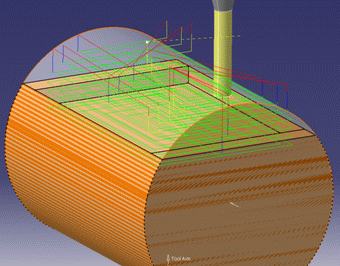
Tool path is optimized to avoid air cutting.
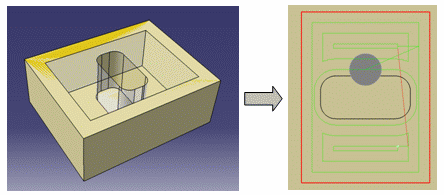
There are no RAPID motion inside intermediate stock. Macro motions are managed to avoid RAPID tool motion inside the material.
Macro motions are automatically updated when a collision (in RAPID mode) is detected with the cutter during toolpath computation by:
In the examples below, the various feedrates are represented as follows:

Update approach macro motion feedrate to avoid RAPID motion inside the stock
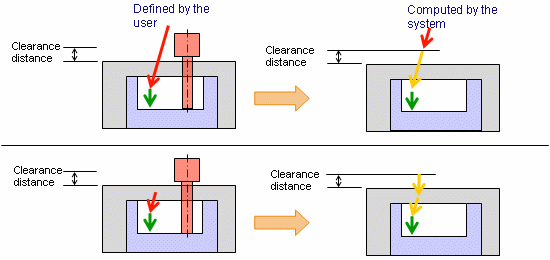
Additional AXIAL macro motion (in Approach feedrate) is added to start outside the stock
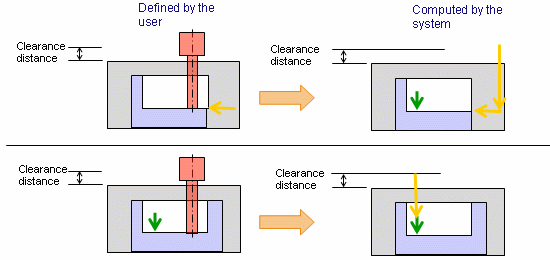
Specific case for ramping and helix approach macros
Macro motion parameter (height) is automatically computed to start outside
the stock
This is done at tool path computation step. Macro motion parameter is not modified
on the macro specified by the user.

Update Retract motion feedrate to avoid RAPID motion inside the stock

Additional Axial macro motion (in Retract feedrate) is added to finish outside the stock

Linking motion between retract and approach
As for axial operations, linking motions are computed according to intermediate
stock.
Linking macro motion is done up to the intermediate stock.
Tool collisions are checked along the linking motion.
The Stock clearance in the
Part Operation
editor is used to define motion without collision with the current stock.

This is supported by the following prismatic operations:
Roughing
Plunge Milling
Cavities Roughing
Pocketing
Facing
Profile Contouring (all modes)
Curve Following
Groove Milling.
Status of the Input intermediate stock
The Input intermediate stock status is up to date:
If the Input intermediate stock is already computed
If all previous operations have a tool path and are up to date or have a locked tool path.
If all previous Output Intermediate stocks are synchronized with the operations.
If the stock assigned in the Part operation has not changed.
In other cases the stock is not up to date.
Intermediate stock status
The Output intermediate stock status is up to date if it is already computed.
The Input intermediate stock status is up to date if the operation has a tool path and is up to date or has a locked tool path.
In other cases the intermediate stock is not up to date.
How to update the Input intermediate stock
You can update the stock as follows:
- click the Input Stock button
- click the Output Stock button
- compute the tool path.
After the computation of the last machining operation of a part operation, all input stocks of the operations of the part operation will be up to date.